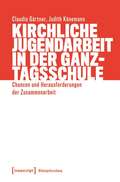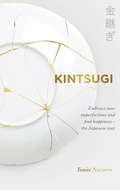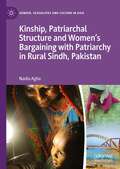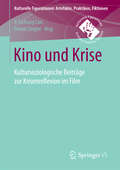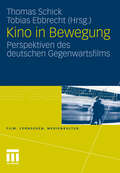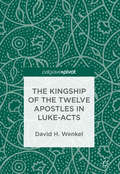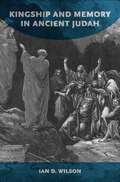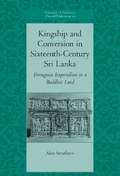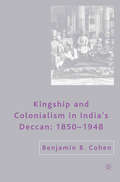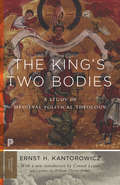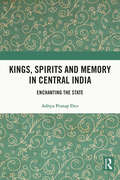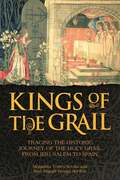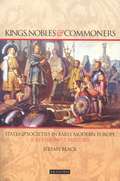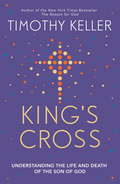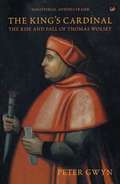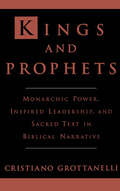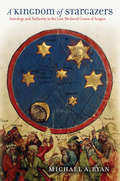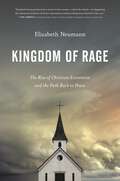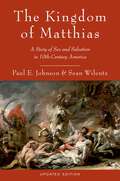- Table View
- List View
Kirchliche Jugendarbeit in der Ganztagsschule: Chancen und Herausforderungen der Zusammenarbeit (Bildungsforschung #15)
by Claudia Gärtner Judith KönemannJugendverbände gehen verstärkt Kooperationen mit Ganztagsschulen ein, weil Kinder und Jugendliche immer mehr (Frei-)Zeit dort verbringen. Die Formen dieser Kooperationen reichen von punktuellen Angeboten bis hin zur Gestaltung des gesamten Ganztagsangebots. Anhand empirischer Fallstudien zum Engagement katholischer Jugendverbände in der Ganztagsschule untersuchen Claudia Gärtner und Judith Könemann Vielfalt, Chancen und Herausforderungen dieser Kooperationen sowie die damit verbundenen Erwartungen und Zielsetzungen. Ihre empirischen Erkundungen bilden die Grundlage für konzeptionelle Entwürfe, wie Schule und kirchliche Jugendverbandsarbeit verstärkt kooperieren können.
Kintsugi: Embrace your imperfections and find happiness - the Japanese way
by Tomás NavarroDiscover how to embrace the imperfect with Kintsugi. Apply this ancient principle to your life and you will learn how to repair yourself, rebuild your life and love your flaws.Japanese Kintsugi masters delicately patch up broken ceramics with gold adhesive, leaving the restoration clearly visible to others. Psychologist Tomás Navarro believes that we should approach our lives with the same philosophy. Everyone faces suffering, but it is the way in which we overcome our troubles, and heal our emotional wounds, that is key. We shouldn't conceal our repairs, they are proof of our strength.Navarro presents real solutions to genuine problems that he has seen in his professional practice. His anecdotes demonstrate that it is possible to transform adversity or setbacks into a strength. His psychological understanding and perspective will leave you feeling courageous and prepared, should you experience misfortune, be it heartbreak, a job loss or bereavement.Often practised alongside Ikigai (or the art of finding one's life purpose), Kintsugi shows you how happiness can be found again, often against all odds. A painful experience can in fact make you a more determined individual, ready to face the world with optimism.'Kintsugi, which translates as "golden joinery", is the latest lifestyle trend promising to transform our lives.' - The Telegraph
Kinship, Patriarchal Structure and Women’s Bargaining with Patriarchy in Rural Sindh, Pakistan (Gender, Sexualities and Culture in Asia)
by Nadia AghaThe book provides insights into the prevailing patriarchal system in rural Pakistan. It elaborates on the kinship system in rural Sindh and explores how young married women strategize and negotiate with patriarchy. Drawing on qualitative methodologies, the book reveals the strong relationship between poverty and the perpetuation of patriarchy. Women’s strategies help elevate their position in their families, such as attention to household tasks, producing children, and doing handicraft work for their well-being. These conditions are usually seen as evidence of women’s subordination, but these are also strategies for survival where accommodation to patriarchy wins them approval. The book concludes that women’s life-long struggle is, in fact, a technique of negotiating with patriarchy. In so doing, they internalize the culture that rests on their subordination and reproduce it in older age in exercising power by oppressing other junior women.
Kino und Krise: Kultursoziologische Beiträge zur Krisenreflexion im Film (Kulturelle Figurationen: Artefakte, Praktiken, Fiktionen)
by Il-Tschung Lim Daniel ZieglerDie Beiträge des vorliegenden Bandes fragen nach den sozial- und kulturwissenschaftlichen Perspektiven einer gesellschaftlichen Reflexion von Krisen und krisenhaften Ereignissen im Medium des fiktionalen Films. Ihnen gemeinsam ist die Annahme, dass Krisen nicht einfach in einer unzweideutig vorliegenden phänomenalen Realität gegeben sind, sie jedoch auch nicht lediglich diskursive Konstruktionen ohne eine eigene Materialität darstellen. Krisen werfen nicht nur Probleme ihrer operativen Bearbeitung auf, sondern konfrontieren Gesellschaften auch mit einem Beobachtungs- und Darstellungsproblem. Was wird wann und vom wem als eine Krise bezeichnet? Welche Vorstellungen, Konzepte, Begriffe, Narrative oder Bilder von Krisen zirkulieren in der Gesellschaft? Wie wird die Krise als ein Wissensobjekt konstituiert? Mit diesen Fragen rücken die spezifischen Verfahren und Prozeduren in der Bezeichnung und Repräsentation von gesellschaftlichen Krisen in den Mittelpunkt der Analyse – und damit jene Repräsentationsmedien, in denen sich die Krisenreflexion ausdrückt. In der Explikation des ästhetisch-epistemologischen Potenzials filmischer Fiktionen liegt dann, so die Grundannahme des vorliegenden Bandes, die Chance auf den spezifischen Mehrwert für eine kultursoziologisch orientierte Filmsoziologie.
Kino in Bewegung: Perspektiven des deutschen Gegenwartsfilms (Film, Fernsehen, Medienkultur)
by Thomas Schick Tobias EbbrechtSeit den Erfolgen von Filmemachern wie Tom Tykwer, Fatih Akin oder der sogenannten „Berliner Schule“ ist das deutsche Gegenwartskino wieder in aller Munde. Ihre Filme konnten sowohl in den heimischen Kinos als auch auf internationalen Festivals überzeugen und haben maßgeblich zur Veränderung und Erneuerung der deutschen Filmlandschaft in den letzten Jahren beigetragen. Doch was hat es mit diesem „Neuen“ des deutschen Gegenwartskinos auf sich? Mit welchen Fragen und Themen beschäftigen sich die Filmemacher, welche ästhetischen Konzepte werden dabei aktualisiert?
The Kingship of the Twelve Apostles in Luke-Acts
by David H. WenkelIn the Gospel of Luke, Jesus promised his disciples kingship and thrones of judgment at the Last Supper. Many commentators have long seen this as a totally futuristic promise that is unrelated to the book of Acts. David H. Wenkel argues that the Twelve inaugurated their co-regency with Christ in the events surrounding Pentecost. This study begins by situating the material of Luke-Acts within the framework of Jewish inaugurated eschatology. It then argues that the kingship promised to the disciples has begun to be fulfilled in the book of Acts. This explains why it was so critically important to replace Judas with Matthias and re-establish the Twelve. It is a step toward re-framing the whole relationship between Luke and Acts within inaugurated eschatology.
The Kingship of the Twelve Apostles in Luke-Acts
by David H. WenkelIn the Gospel of Luke, Jesus promised his disciples kingship and thrones of judgment at the Last Supper. Many commentators have long seen this as a totally futuristic promise that is unrelated to the book of Acts. David H. Wenkel argues that the Twelve inaugurated their co-regency with Christ in the events surrounding Pentecost. This study begins by situating the material of Luke-Acts within the framework of Jewish inaugurated eschatology. It then argues that the kingship promised to the disciples has begun to be fulfilled in the book of Acts. This explains why it was so critically important to replace Judas with Matthias and re-establish the Twelve. It is a step toward re-framing the whole relationship between Luke and Acts within inaugurated eschatology.
Kingship and Memory in Ancient Judah
by Ian D. WilsonKingship and Memory in Ancient Judah addresses the question of how a postmonarchic society would remember and imagine its monarchy, and kingship in general, as part of its past, present, and future. How did Judeans of the early Second Temple period conceive of the monarchy? By way of a thorough analysis of Judean discourse in this era, Ian D. Wilson argues that ancient Judeans had no single way of remembering and imagining kingship. In fact, their memory and imaginary was thoroughly multivocal, and necessarily so. Judean historiographical literature evinces a mindset that was unsure of the monarchic past and how to understand it-multiple viewpoints were embraced and brought into conversation with one another. Similarly, prophetic literature, which drew on the discursive themes of the remembered past, envisions a variety of outcomes for kingship's future. Historiographical and prophetic literature thus existed in a kind of feedback loop, enabling, informing, and balancing each other's various understandings of kingship as part of Judean society and life. Through his investigation of kingship in Judean discourse, Wilson contributes to our knowledge of literature and literary culture in ancient Judah and also makes a significant contribution to questions of history and historiographical method in biblical studies.
Kingship and Memory in Ancient Judah
by Ian D. WilsonKingship and Memory in Ancient Judah addresses the question of how a postmonarchic society would remember and imagine its monarchy, and kingship in general, as part of its past, present, and future. How did Judeans of the early Second Temple period conceive of the monarchy? By way of a thorough analysis of Judean discourse in this era, Ian D. Wilson argues that ancient Judeans had no single way of remembering and imagining kingship. In fact, their memory and imaginary was thoroughly multivocal, and necessarily so. Judean historiographical literature evinces a mindset that was unsure of the monarchic past and how to understand it-multiple viewpoints were embraced and brought into conversation with one another. Similarly, prophetic literature, which drew on the discursive themes of the remembered past, envisions a variety of outcomes for kingship's future. Historiographical and prophetic literature thus existed in a kind of feedback loop, enabling, informing, and balancing each other's various understandings of kingship as part of Judean society and life. Through his investigation of kingship in Judean discourse, Wilson contributes to our knowledge of literature and literary culture in ancient Judah and also makes a significant contribution to questions of history and historiographical method in biblical studies.
Kingship And Conversion In Sixteenth-century Sri Lanka: Portuguese Imperialism In A Buddhist Land (University Of Cambridge Oriental Publications #66)
by Alan StrathernWhen the Portuguese arrived on the shores of Sri Lanka in 1506, they opened an era in which religious identity became central to struggles for power on the island. During the reign of King Bhuvanekabahu VII (1521–51), they became the first European empire to dominate Lankan politics. This book sets out to explain the behaviour of the Portuguese and the Sinhalese as their relationship evolved over the century. Topics covered include the nature of Portuguese imperialism and indigenous state power in the earlier decades, the impact of Catholic mission on this Buddhist society and how this was shaped by local principles of caste, land tenure and religious thought, and the issue of identity. It reveals how indigenist, dynastic, and religious loyalties shaped the increasingly violent conflicts of the later decades. The principal concern is the sacred legitimization of kingship: why was Christian monarchy never truly established in Sri Lanka?
Kingship and Colonialism in India’s Deccan 1850–1948
by B. CohenRejecting simplified notions of 'civilizational clashes', this book argues for a new perspective on Hindu, Muslim, and colonial power relations in India. Using archival sources from London, Delhi, and Hyderabad, the book makes use of interviews, private family records and princely-colonial records uncovered outside of the archival repositories.
The King's Two Bodies: A Study in Medieval Political Theology
by Ernst Kantorowicz Conrad Leyser William Chester JordanOriginally published in 1957, this classic work has guided generations of scholars through the arcane mysteries of medieval political theology. Throughout history, the notion of two bodies has permitted the post mortem continuity of monarch and monarchy, as epitomized by the statement, "The king is dead. Long live the king." In The King's Two Bodies, Ernst Kantorowicz traces the historical problem posed by the "King's two bodies"--the body natural and the body politic--back to the Middle Ages and demonstrates, by placing the concept in its proper setting of medieval thought and political theory, how the early-modern Western monarchies gradually began to develop a "political theology.?The king's natural body has physical attributes, suffers, and dies, naturally, as do all humans; but the king's other body, the spiritual body, transcends the earthly and serves as a symbol of his office as majesty with the divine right to rule. The notion of the two bodies allowed for the continuity of monarchy even when the monarch died, as summed up in the formulation "The king is dead. Long live the king." Bringing together liturgical works, images, and polemical material, The King's Two Bodies explores the long Christian past behind this "political theology." It provides a subtle history of how commonwealths developed symbolic means for establishing their sovereignty and, with such means, began to establish early forms of the nation-state. Kantorowicz fled Nazi Germany in 1938, after refusing to sign a Nazi loyalty oath, and settled in the United States. While teaching at the University of California, Berkeley, he once again refused to sign an oath of allegiance, this one designed to identify Communist Party sympathizers. He was dismissed as a result of the controversy and moved to the Institute for Advanced Study in Princeton, where he remained for the rest of his life, and where he wrote The King's Two Bodies.Featuring a new introduction, The King's Two Bodies is a subtle history of how commonwealths developed symbolic means for establishing their sovereignty and, with such means, began to establish early forms of the nation-state.
The King's Two Bodies: A Study in Medieval Political Theology
by Ernst Kantorowicz Conrad Leyser William Chester JordanOriginally published in 1957, this classic work has guided generations of scholars through the arcane mysteries of medieval political theology. Throughout history, the notion of two bodies has permitted the post mortem continuity of monarch and monarchy, as epitomized by the statement, "The king is dead. Long live the king." In The King's Two Bodies, Ernst Kantorowicz traces the historical problem posed by the "King's two bodies"--the body natural and the body politic--back to the Middle Ages and demonstrates, by placing the concept in its proper setting of medieval thought and political theory, how the early-modern Western monarchies gradually began to develop a "political theology.?The king's natural body has physical attributes, suffers, and dies, naturally, as do all humans; but the king's other body, the spiritual body, transcends the earthly and serves as a symbol of his office as majesty with the divine right to rule. The notion of the two bodies allowed for the continuity of monarchy even when the monarch died, as summed up in the formulation "The king is dead. Long live the king." Bringing together liturgical works, images, and polemical material, The King's Two Bodies explores the long Christian past behind this "political theology." It provides a subtle history of how commonwealths developed symbolic means for establishing their sovereignty and, with such means, began to establish early forms of the nation-state. Kantorowicz fled Nazi Germany in 1938, after refusing to sign a Nazi loyalty oath, and settled in the United States. While teaching at the University of California, Berkeley, he once again refused to sign an oath of allegiance, this one designed to identify Communist Party sympathizers. He was dismissed as a result of the controversy and moved to the Institute for Advanced Study in Princeton, where he remained for the rest of his life, and where he wrote The King's Two Bodies.Featuring a new introduction, The King's Two Bodies is a subtle history of how commonwealths developed symbolic means for establishing their sovereignty and, with such means, began to establish early forms of the nation-state.
Kings, Spirits and Memory in Central India: Enchanting the State
by Aditya Pratap DeoPart anthropological history and part memoir, this book is a unique study of the polity of the colonial-princely state of Kanker in central India. The author, a scion of the erstwhile ruling family of Kanker, delves into the oral accounts given in the ancestral deity practices of the mixed tribe-caste communities of the region to highlight popular narratives of its historical polity. As he struggles with his own dilemmas as ethnographer-king, what comes into view is a polity where the princely state is drawn out amidst a terrain of gods and spirits as much as that of law courts and magistrates, and political power is divided, contested and shared between the raja/state and the people. This study constitutes not only an intervention in the larger debate on the relationship between state formations and tribal peoples, but also on the very nature of history as a knowledge practice, especially the understandings of power, authority and sovereignty in it. Combining intensive ethnography, complementary archival work and crucial theoretical questions engaging social scientists worldwide, the author charts an unusual explanatory path that can allow us to meaningfully understand societies/peoples that have historically been marginalized and seen as different. This book will be of interest to students and researchers of history, anthropology, politics, religion, tribal society and Modern South Asia.
Kings, Spirits and Memory in Central India: Enchanting the State
by Aditya Pratap DeoPart anthropological history and part memoir, this book is a unique study of the polity of the colonial-princely state of Kanker in central India. The author, a scion of the erstwhile ruling family of Kanker, delves into the oral accounts given in the ancestral deity practices of the mixed tribe-caste communities of the region to highlight popular narratives of its historical polity. As he struggles with his own dilemmas as ethnographer-king, what comes into view is a polity where the princely state is drawn out amidst a terrain of gods and spirits as much as that of law courts and magistrates, and political power is divided, contested and shared between the raja/state and the people. This study constitutes not only an intervention in the larger debate on the relationship between state formations and tribal peoples, but also on the very nature of history as a knowledge practice, especially the understandings of power, authority and sovereignty in it. Combining intensive ethnography, complementary archival work and crucial theoretical questions engaging social scientists worldwide, the author charts an unusual explanatory path that can allow us to meaningfully understand societies/peoples that have historically been marginalized and seen as different. This book will be of interest to students and researchers of history, anthropology, politics, religion, tribal society and Modern South Asia.
Kings of the Grail: Tracing the Historic Journey of the Holy Grail from Jerusalem to Spain
by Margarita Torres Sevilla José Miguel Ortega del RíoAn extraordinary investigation, beginning with ancient parchments in Egypt and ending in Spain, casts an entirely new light on the fascinating mystery of the Holy Grail.Recently discovered parchments in Egypt have finally made it possible to identify the current location of the Holy Grail. This extraordinary discovery led Margarita Torres Sevilla and José Miguel Ortega del Río on a three-year investigation as they traced the Grail's journey across the globe to its final resting place in the Basilica of San Isidoro in León, Spain. * Traces the history of the Grail from Jerusalem in the eleventh century, to the caliph of the Fatimid dynasty, the Muslim prince of Dénia (in Spain) and finally to Ferdinand I of León and Castile.* This definitive book on one of history's most sought-after treasures, the object of both Arthurian myth and Christian legend, has made headlines worldwide.* The culmination of a meticulous three-year investigation and supported by historical and scientific research.* Includes fascinating facts about the history of Judaism and early Christianity, the significance of the Last Supper, and the other cups previously identified as the Holy Grail.Meticulously researched, this is a fascinating and unique guide to history of the Grail.
Kings, Nobles and Commoners: States and Societies in Early Modern Europe
by Jeremy BlackWas Protestantism `better' than Catholicism, contributing to well organised societies and economic enterprise? Or was Catholicism the religion of reactionary and backward states and societies like Spain and Austria, in contrast to the thrusting and modern bourgeois states of the United Netherlands and England? Certainly Spain and Austria declined but France, although Catholic and absolutist, rose to greatness, although the argument might be sustained by Britain's global triumph in the 18th century.Closely linked is the rise of the modern state in Europe and Russia - increasingly `European' under Peter the Great - and the Ottoman Empire. What was the structure of the modern state? Did rulers with administrative sophistication and centralisaton, buttresssed by a growing cadre of middle class civil servants - the `noblesse du robe' - and military and naval power, exercise absolute power over state and society? Or was royal absolutism a `myth', grand in display but bankrupt, increasingly opposed by all parts of society, and to swept away in revolution?Jeremy Black, one of the most prolific and stimulating scholars of early modern Europe sets his history in the context of the Middle East, Central, South and East and Asia and the New World, shows how Europe fits into a world view, and demonstrates that with the exception of Peter the Great's Russia, royal power in early modern Europe was based on compromise and traditional relationships with the aristocracy and gentry, the Estates, corporations, the church and with an element of common consent. Commercial progress was widespread, boundaries were stabilised, and European financial, technical and mineral resources fuelled New World expansion - until the revolutionary deluge after 1789.
King's Cross: Understanding the Life and Death of the Son of God
by Timothy KellerUnpredictable yet reliable, gentle yet powerful, authoritative yet humble, human yet divine.' At a time when interest in Jesus has never been higher, respected pastor and bestselling author Tim Keller takes a deep and thought-provoking look at the life of Christ. Drawing from Mark's gospel, he explains how Jesus' identity as king and his purpose in dying on the cross have meaning and significance on a cosmic scale as well as for the individual. THE REASON FOR GOD gave a passionate and intellectually compelling case for God, while THE PRODIGAL GOD explored the gospel's central message of grace. Now KING'S CROSS gives a captivating account of the person at the heart of it all: Jesus. Written in Keller's trademark authoritative yet inviting style, this book will unlock new insights for believers and unbelievers alike.
The King's Cardinal: The Rise and Fall of Thomas Wolsey
by Peter J GwynProud, greedy, corrupt and driven by overwhelming personal ambition. Such is the traditional image of Thomas Wolsey, Lord Chancellor, Archbishop of York, Bishop of Winchester, Abbot of St. Albans, Bishop if Tournai and Papal Legate. It is an image which Peter Gwyn examines, challenges and decisively overturns in this remarkable book.From exceedingly humble beginnings Wolsey rose to a pinnacle of power unsurpassed by any other British commoner. Peter Gwyn explores every aspect of the Cardinal's career - not least his relationship with Henry VIII - and sets it firmly in a vividly recreated Tudor world. The Wolsey who emerges is a man of prodigious energy and ability, a tireless dispenser of justice, an enlightened reformer wholly dedicated to his king and country - a man who has been consistently misrepresented and maligned for four-and-a-half centuries.
Kings And Prophets: Monarchic Power, Inspired Leadership, And Sacred Text In Biblical Narrative
by Cristiano GrottanelliThis collection of essays examines the respective religious and social functions of kings and prophets as they are presented in the biblical narratives. Biblical kingship is easily shown to be a specific instance of an ancient and widespread institution--sacred monarchy--that was the pivot of most state organizations throughout antiquity; prophetic authority is described as a typical institution of ancient Hebrew society. The difference between monarchy and prophecy is radical, because the former implies a hereditary power and is upheld by its subjects who feed their kings with taxes, while the latter derives its authority from allegedly direct divine inspiration, and though it is also economically dependent it is not explicitly presented as being based upon systematic exploitation. Cristiano Grottanelli interprets the rise of prophecy as a consequence of a crisis of monarchical structures at the beginning of the Iron Age, and connects it to similar phenomena attested in ancient Greek texts derived from a similar crisis. Though monarchy finally won the day in the Ancient Mediterranean in a new imperial form, the new literatures in Greek and Hebrew consonantic and alphabetic scripts shaped nonmonarchic figures to which they attributed some of the functions previously pertaining to monarchy. These new literatures, produced by two cultures that were both highly literate and organized according to nonmonarchical principles, diverged radically in their development and final outcomes. In the Hebrew tradition, monolatry and an official canon of sacred writings were the final result; the prophetic principle was thus overcome by a new ideological construction, centered upon inspired scriptures rather than upon the impromptu performances of inspired persons. In using the prophetic principle against the monarchic, the canonical texts paradoxically shaped their own authority above that of living prophets.
Kings and Prophets: Monarchic Power, Inspired Leadership, and Sacred Text in Biblical Narrative
by Cristiano GrottanelliThis collection of essays examines the respective religious and social functions of kings and prophets as they are presented in the biblical narratives. Biblical kingship is easily shown to be a specific instance of an ancient and widespread institution--sacred monarchy--that was the pivot of most state organizations throughout antiquity; prophetic authority is described as a typical institution of ancient Hebrew society. The difference between monarchy and prophecy is radical, because the former implies a hereditary power and is upheld by its subjects who feed their kings with taxes, while the latter derives its authority from allegedly direct divine inspiration, and though it is also economically dependent it is not explicitly presented as being based upon systematic exploitation. Cristiano Grottanelli interprets the rise of prophecy as a consequence of a crisis of monarchical structures at the beginning of the Iron Age, and connects it to similar phenomena attested in ancient Greek texts derived from a similar crisis. Though monarchy finally won the day in the Ancient Mediterranean in a new imperial form, the new literatures in Greek and Hebrew consonantic and alphabetic scripts shaped nonmonarchic figures to which they attributed some of the functions previously pertaining to monarchy. These new literatures, produced by two cultures that were both highly literate and organized according to nonmonarchical principles, diverged radically in their development and final outcomes. In the Hebrew tradition, monolatry and an official canon of sacred writings were the final result; the prophetic principle was thus overcome by a new ideological construction, centered upon inspired scriptures rather than upon the impromptu performances of inspired persons. In using the prophetic principle against the monarchic, the canonical texts paradoxically shaped their own authority above that of living prophets.
A Kingdom of Stargazers: Astrology and Authority in the Late Medieval Crown of Aragon
by Michael A. RyanAstrology in the Middle Ages was considered a branch of the magical arts, one informed by Jewish and Muslim scientific knowledge in Muslim Spain. As such it was deeply troubling to some Church authorities. Using the stars and planets to divine the future ran counter to the orthodox Christian notion that human beings have free will, and some clerical authorities argued that it almost certainly entailed the summoning of spiritual forces considered diabolical. We know that occult beliefs and practices became widespread in the later Middle Ages, but there is much about the phenomenon that we do not understand. For instance, how deeply did occult beliefs penetrate courtly culture and what exactly did those in positions of power hope to gain by interacting with the occult? In A Kingdom of Stargazers, Michael A. Ryan examines the interest in astrology in the Iberian kingdom of Aragon, where ideas about magic and the occult were deeply intertwined with notions of power, authority, and providence. Ryan focuses on the reigns of Pere III (1336–1387) and his sons Joan I (1387–1395) and Martí I (1395–1410). Pere and Joan spent lavish amounts of money on astrological writings, and astrologers held great sway within their courts. When Martí I took the throne, however, he was determined to purge Joan’s courtiers and return to religious orthodoxy. As Ryan shows, the appeal of astrology to those in power was clear: predicting the future through divination was a valuable tool for addressing the extraordinary problems—political, religious, demographic—plaguing Europe in the fourteenth century. Meanwhile, the kings' contemporaries within the noble, ecclesiastical, and mercantile elite had their own reasons for wanting to know what the future held, but their engagement with the occult was directly related to the amount of power and authority the monarch exhibited and applied. A Kingdom of Stargazers joins a growing body of scholarship that explores the mixing of religious and magical ideas in the late Middle Ages.
Kingdom of Rage: The Rise of Christian Extremism and the Path Back to Peace
by Elizabeth NeumannA former counterterrorism official explores how modern evangelicalism and right-wing conservatism intermingled to form the combustible ideology that resulted in the January 6 attacks on the Capitol—and which threatens to destroy the American Church from within. How did a Church that purports to follow the teachings of Jesus - the Prince of Peace - become a breeding ground for violent extremism? When Elizabeth Neumann began her anti-terrorism career as part of President George W. Bush&’s Homeland Security Counsel in the wake of the September 11 attacks, she expected to spend her life protecting her country from the threat of global terrorism. But as her career evolved, she began to perceive that the greatest threat to American security came not from religious fundamentalists in Afghanistan or Iraq but from white nationalists and radicalized religious fundamentalists within the very institution that was closest to her heart – the American evangelical church. And she began to sound the alarm, raising her concerns to anyone in government who would listen, including testifying before Congress in February of 2020. At that time, Neumann warned that anti-Semitic and white supremacist terrorism was a transnational threat that was building to the doorstep of another major attack. Shortly after her testimony, she resigned from her role as Department of Homeland Security Assistant Secretary for Counterterrorism and Threat Prevention in protest of what she believed was then-President Trump&’s failure of leadership and his stoking of the hatred, anger, and division from which she had dedicated her life to protecting her country. Her worst fears came true when she witnessed the attack on the capital on January 6, 2021. In Kingdom of Rage, Neumann explores the forces within American society that have encouraged the radicalization of white supremacist, anti-government and other far-right terrorists by co-opting Christian symbols and culture and perverting the faith&’s teachings. While Neumann offers decades of insights into the role government policies can play to prevent further bloodshed, she believes real change must come from the within the Christian church. She shines a bright light on the responsibility of ordinary Americans – and particularly American Christians – to work within their families and their communities to counteract the narrative of victimization and marginalization within American evangelicalism. Her goal for this book is not only to sound a warning about one of the greatest threats to our security but to rescue the Church from the forces that will, if left unchecked, destroy it – culturally, morally, and ultimately quite literally. This is a book for anyone who wants to understand the unholy marriage of right-wing politics and Christian exceptionalism in America and who wants to be a part of reversing the current path towards division, hatred, violence and the ultimate undermining of both evangelical Christianity and American democracy.
The Kingdom of Matthias: A Story of Sex and Salvation in 19th-Century America
by Paul E. Johnson Sean WilentzPaul Johnson and Sean Wilentz brilliantly recapture the forgotten story of Matthias the Prophet, imbuing their richly researched account with the dramatic force of a novel. In the hands of Johnson and Wilentz, the strange tale of Matthias opens a fascinating window into the turbulent movements of the religious revival known as the Second Great Awakening--movements that swept up great numbers of evangelical Americans and gave rise to new sects like the Mormons. Into this teeming environment walked a down-and-out carpenter named Robert Matthews, who announced himself as Matthias, prophet of the God of the Jews. His hypnotic personality drew in a cast of unforgettable characters--the meekly devout businessman Elijah Pierson, who once tried to raise his late wife from the dead; the young attractive Christian couple, Benjamin Folger and his wife Ann (who seduced the woman-hating Prophet); and the shrewd ex-slave Isabella Van Wagenen, regarded by some as "the most wicked of the wicked." None was more colorful than the Prophet himself, a bearded, thundering tyrant who gathered his followers into an absolutist household, using their money to buy an elaborate, eccentric wardrobe, and reordering their marital relations. By the time the tensions within the kingdom exploded into a clash with the law, Matthias had become a national scandal.
The Kingdom of Matthias: A Story of Sex and Salvation in 19th-Century America
by Paul E. Johnson Sean WilentzPaul Johnson and Sean Wilentz brilliantly recapture the forgotten story of Matthias the Prophet, imbuing their richly researched account with the dramatic force of a novel. In the hands of Johnson and Wilentz, the strange tale of Matthias opens a fascinating window into the turbulent movements of the religious revival known as the Second Great Awakening--movements that swept up great numbers of evangelical Americans and gave rise to new sects like the Mormons. Into this teeming environment walked a down-and-out carpenter named Robert Matthews, who announced himself as Matthias, prophet of the God of the Jews. His hypnotic personality drew in a cast of unforgettable characters--the meekly devout businessman Elijah Pierson, who once tried to raise his late wife from the dead; the young attractive Christian couple, Benjamin Folger and his wife Ann (who seduced the woman-hating Prophet); and the shrewd ex-slave Isabella Van Wagenen, regarded by some as "the most wicked of the wicked." None was more colorful than the Prophet himself, a bearded, thundering tyrant who gathered his followers into an absolutist household, using their money to buy an elaborate, eccentric wardrobe, and reordering their marital relations. By the time the tensions within the kingdom exploded into a clash with the law, Matthias had become a national scandal.
